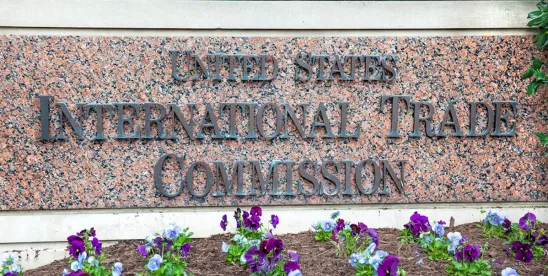Mandatory deference to an agency’s rulemaking may be gone, and numerous commentators fear that the Supreme Court’s decision in Loper Bright Enterprises v. Raimondo will drastically alter the legal landscape surrounding agency decisions. But that does not mean that every agency or agency decision is in peril. We explore here the implications of the Loper Bright decision on the U.S. International Trade Commission (“ITC”), when it conducts investigations under Section 337 of the Tariff Act of 1930 relating to alleged violations of intellectual property rights (e.g., allegations of patent infringement), which typically involve decisions of technical and economic analysis rather than rulemaking. Our analysis suggests that the ITC’s body of experience and a long history of judicial review of ITC Section 337 decisions should minimize the impact of the Loper decision on Section 337 investigations.
The Loper Bright Decision
In Loper Bright, the Supreme Court overturned decades of precedent by abolishing the so-called Chevron doctrine, which instructed courts to give deference to federal agency interpretations of ambiguous statutes. The Chevron doctrine required that, when interpreting an agency statute, a court should first decide whether a statute is ambiguous, and if determined to be ambiguous, then the court must defer to Congress’s interpretation, if available, or to the interpretation by an agency if the agency has a “permissible construction on the statute.” This deference became known as Chevron deference.
On June 28, 2024, the Supreme Court in Loper Bright held that the Administrative Procedures Act (“APA”) requires courts to “exercise independent judgment” in deciding whether an agency has acted within its statutory authority when interpreting the meaning of a statutory provision. The Supreme Court explicitly overruled Chevron and abolished the rule that deference must be provided to an agency’s interpretation of an ambiguous statute. According to the Supreme Court, “[w]hen the best reading of a statute is that it delegates discretionary authority to an agency, the role of the reviewing court under the APA is, as always, to independently interpret the statute and effectuate the will of Congress subject to constitutional limits.”
The Loper Bright Court provided further guidance to courts facing this issue. The majority opinion directs courts to follow Skidmore v. Swift & Co., 323 U.S. 134 (1944), a pre-APA case. According to Skidmore, a court reviewing an agency’s interpretation of ambiguous statutory provisions is not required to follow the agency’s interpretation, and instead should independently decide how much deference to give an agency based on “the thoroughness evident in its consideration, the validity of its reasoning, its consistency with earlier and later pronouncements, and all those factors which give it power to persuade, if lacking power to control.”
Chevron Deference at the ITC: Suprema
There are a limited number of decisions applying Chevron deference to Section 337 issues at the ITC. One example is Suprema, Inc. v. Int’l Trade Comm’n, 796 F.3d 1338 (Fed. Cir. 2015) in which the Federal Circuit affirmed the ITC’s interpretation of Section 337 to cover articles that do not infringe at the time of importation, but which are used, after importation, to directly infringe at the inducement of the seller.
Suprema manufactured scanners for fingerprints that are not standalone products and must be connected to a computer installed with custom software. Suprema did not make or sell the software. Instead, each scanner was shipped with software that could be used by a third-party distributor for developing custom programs to control the scanners. Thus, Suprema’s products did not directly infringe at the time of importation, and direct infringement only occurred when the scanners were used by a third-party distributor.
As discussed in our prior blog (here), the ITC held that Suprema actively encouraged direct infringement by its distributors and therefore was liable for inducement. The Federal Circuit held that the ITC’s interpretation was entitled to Chevron deference and upheld the ITC’s interpretation that importation of non-infringing articles, which are later used by another to directly infringe as a result of inducement, may be barred from importation under Section 337.
The Effect of Suprema post-Loper
It appears likely that the Federal Circuit would reach the same conclusion today, applying the Skidmore analysis, that the Suprema Court reached in 2015.
The Suprema Court found “[n]othing in nearly a century of U.S. trade law enactments is inconsistent with the Commission’s interpretation.” Additionally, the Suprema Court found that “[t]his court has consistently affirmed the Commission’s determination that a violation of Section 337 may arise from an act of induced infringement.” The Court would not, today, provide automatic deference to the ITC’s interpretation of section 337, but these and other statements in the Suprema decision demonstrate “thoroughness evident in its consideration, the validity of its reasoning, [and] consistency with earlier and later pronouncements” – all of which support deference under Skidmore to the ITC’s decision.
Also, more generally, Loper held that an agency’s interpretation may “constitute a body of experience and informed judgment to which courts and litigants may properly resort for guidance” and that “all existing decisions, even under the flawed Chevron methodology, are entitled to stare decisis weight.” Because the ITC’s interpretation in the Suprema case was consistent with historical U.S. trade law policy and decisions, a court today should reach the same conclusion applying Loper and Skidmore.
Takeaways
The Supreme Court’s decision in Loper Bright Enterprises v. Raimondo is predicted to drastically alter the legal landscape surrounding many agency decisions. We expect, however, that its effect on ITC Section 337 investigations will be minimal.
Nevertheless, one ongoing case to watch is Sonos, Inc. v. ITC, Federal Circuit Appeal Nos. 2022-1421 & 2022-1573, in which Google filed a petition for panel rehearing and/or rehearing en banc in light of the Loper decision. In this case, the Federal Circuit relied on the Chevron doctrine and affirmed an ITC decision under Suprema barring imports of Google smartphones and speakers. As in Suprema, the articles barred from importation – smartphones and speakers – do not infringe at the time of importation; they only infringe after importation when users download apps or configure them. Google asked the Court to reconsider under the new Loper standard, and both the ITC and Sonos opposed. On September 10, 2024, the Federal Circuit denied Google’s requests. However, Google can still file a petition for certiorari with the U.S. Supreme Court.




 />i
/>i

